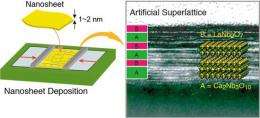Novel tailor-made nanoferroelectric from building blocks

A research group at the Japan's National Institute for Materials Science have successfully developed a novel nanoferroelectric by a solution-based bottom-up nanotechnology.
A research group headed by MANA Scientist Dr. Minoru Osada and Principal Investigator Dr. Takayoshi Sasaki of the International Center for Materials Nanoarchitectonics at the National Institute for Materials Science successfully developed a novel nanoferroelectric by a solution-based bottom-up nanotechnology.
Ferroelectric materials are one of dielectrics that possess spontaneous and reversible electric dipole moments — an electric polarization remains after applying and removing an external electric field, from which ferroelectric materials can be worked as a nonvolatile memory, representing "0" in one orientation and "1" in the other. Ferroelectric memory (FeRAM) features high-speed access, high endurance in write mode, low power consumption, non-volatility, and excellent tamper resistance. It is therefore ideal memory for use in smart cards, as well as cellular phones and other devices. The continuous downscaling of microelectronic circuits combined with increasing interest in ferroelectric thin films for FeRAMs is drawing great attention to ferroelectric nanostructures / nanofilms. Until recently, it was technologically difficult to stabilize ferroelectricity on the nanoscale.
Seeking to develop a new nanoferroelectrics, this research group created a superlattice film based molecularly-thin oxide nanosheets as building blocks. The group synthesized two different perovskite nanosheets (Ca2Nb3O10, LaNb2O7), and fabricated an artificial superlattice by alternately stacking of two nanosheets via solution-based layer-by-layer assembly, in the same way that children play with building blocks. By artificial structuring, the group found that, in contrast to the paraelectric nature of Ca2Nb3O10 and LaNb2O7, the (LaNb2O7/Ca2Nb3O10) superlattice possesses a new form of interface coupling, which gives rise to ferroelectricity at room temperature. This artificial superlattice exhibited robust ferroelectric properties even at several nanometer thicknesses, which is the world’s thinnest level. This achievement has a great potential for the rational design and construction of nanoferroelectrics, and will also open a new route to the development of lead-free ferroelectric devices desirable for future electronic equipments.
The results was published in ACS Nano on November 23.
More information:
Provided by National Institute for Materials Science


















